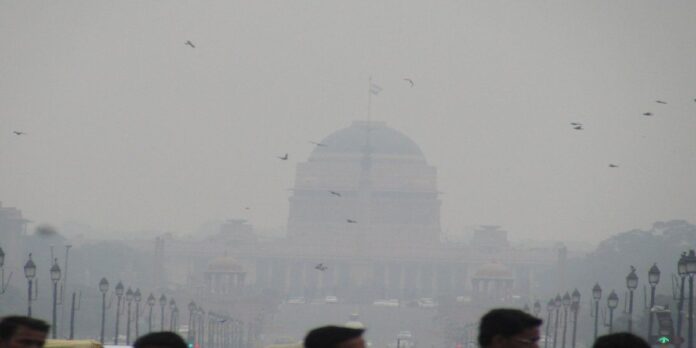The air pollution crisis in Delhi stems from a complex interplay of multiple sources. Together they contribute to an annual crisis, with the Indian capital often ranking among the world’s most polluted cities.
For the residents of Delhi-National Capital Region (NCR), the choice is clear: continue down the path of “death-by-breath” or strive for a future with a fundamental right to clean air.
Cleaner air over Delhi-NCR is achievable, but the path is fraught with several policy challenges. While measures like the Graded Response Action Plan (GRAP) and the National Clean Air Programme (NCAP) have been introduced to mitigate air pollution, these provide only short-term relief.
The findings from a 2018 study by The Energy and Resources Institute (TERI) on Delhi-NCR air quality offer valuable insights into sources of pollution, breaking down their contributions to concentrations of inhalable particulate matter (less than 2.5 micrometre in diameter or PM2.5).
Vehicular emissions are responsible for approximately 24 percent of the city’s particulate matter levels. Industrial activities, particularly from neighbouring states, account for 23 percent of the PM2.5 pollution, fuelled by outdated technologies and lax enforcement of emission standards.
Residential biomass burning in rural areas surrounding Delhi adds another 18 percent, especially during winter when biomass is used for heating and cooking. Dust from construction activities and poorly managed roads contribute 27 percent to particulate matter levels.
Seasonal crop residue burning activities in neighbouring states – Haryana, Punjab, Uttar Pradesh, and Rajasthan – which spike during October and November significantly influence Delhi’s air quality. For instance, the widespread burning of crop residues in Punjab and Haryana during the
post-monsoon season is a major factor behind Delhi’s infamous winter smog.
The root causes of crop residue burning are policy incentives to grow rice in this arid region, originally intended for the purpose of food security, but no longer necessary.
Further, a policy diktat by Punjab and Haryana banning rice sowing till the monsoon begins, without a proper hydrological study on the actual impact of pre-monsoon sowing on the groundwater table, leaves no time for farmers to properly harvest and utilise the crop waste. This leaves them with no option but to burn crop waste.
However, farmers are an important political constituency, and these perverse policy incentives must be replaced with others that leave the farmer no worse off.
TERI’s study reveals that Delhi’s emissions contribute, on average, only 36 percent to the city’s inhalable particulate matter concentrations in winter and 26 percent in summer, with the rest originating outside the city.
A promising approach to tackling Delhi’s persistent air pollution is the concept of airshed management, which views air pollution as a regional challenge.
Effective airshed management requires collaboration across these regions to monitor and control emissions, recognising that pollutants transcend state boundaries.
Building a comprehensive emissions inventory for the entire airshed and conducting source apportionment studies can help identify pollution hotspots and guide targeted interventions.
Equally important is the transition to cleaner energy sources.
Delhi has reduced its reliance on coal by shutting down thermal power plants. However, the city and its surrounding regions must further accelerate their shift toward renewable energy sources such as solar and wind.
Expanding Delhi’s fleet of electric buses and providing incentives for electric vehicles can also reduce vehicular emissions. Charging infrastructure must be scaled up to support the growing adoption of EVs, while stringent emission norms for petrol and diesel vehicles should be enforced.
Another critical area is urban planning and infrastructure development. Poorly managed construction activities generate significant amounts of dust, exacerbating air pollution. Adopting best practices such as covering construction sites, using water sprays over dust, and enforcing strict waste disposal regulations can help mitigate this problem.
Urban greenery also plays a vital role in absorbing pollutants and regulating the local climate or “micro-climate”. Expanding green spaces and creating green belts around the city can provide a natural buffer against air pollution.
More technological interventions are also necessary. Advanced air-quality monitoring networks capable of providing real-time data are essential for tracking pollution levels and implementing timely mitigation measures.
Artificial intelligence and machine learning can predict pollution episodes and identify high-risk areas, enabling authorities to take pre-emptive action. Smog towers and large-scale air purifiers, while not a panacea, can serve as supplementary tools in areas with persistently high pollution levels.
Public participation is a cornerstone of any successful long-term strategy. Campaigns encouraging the use of public transport, carpooling, and segregation of wet and dry waste can significantly reduce air pollution.
Community-based initiatives, such as citizen science projects for air-quality monitoring, can foster a sense of responsibility and empower individuals to advocate for cleaner air.
Incentivising industries to adopt cleaner production processes and renewable energy can reduce their environmental footprint without compromising economic growth.
Moreover, creating job opportunities in green sectors such as renewable energy, waste management, and sustainable transport can strike a balance between economic development and environmental sustainability.
Addressing Delhi’s air pollution also requires policy reforms at the national and state levels.
Delhi can also draw inspiration from cities around the world like Beijing and Los Angeles that have successfully tackled air pollution.
Controlling air pollution is not an insurmountable problem.
About author: Suresh Ramasubramanya Iyer is Senior Fellow and Area Convenor, Centre for Air Quality Research, The Energy and Resources Institute, New Delhi.
Originally published under Creative Commons by 360info™.





